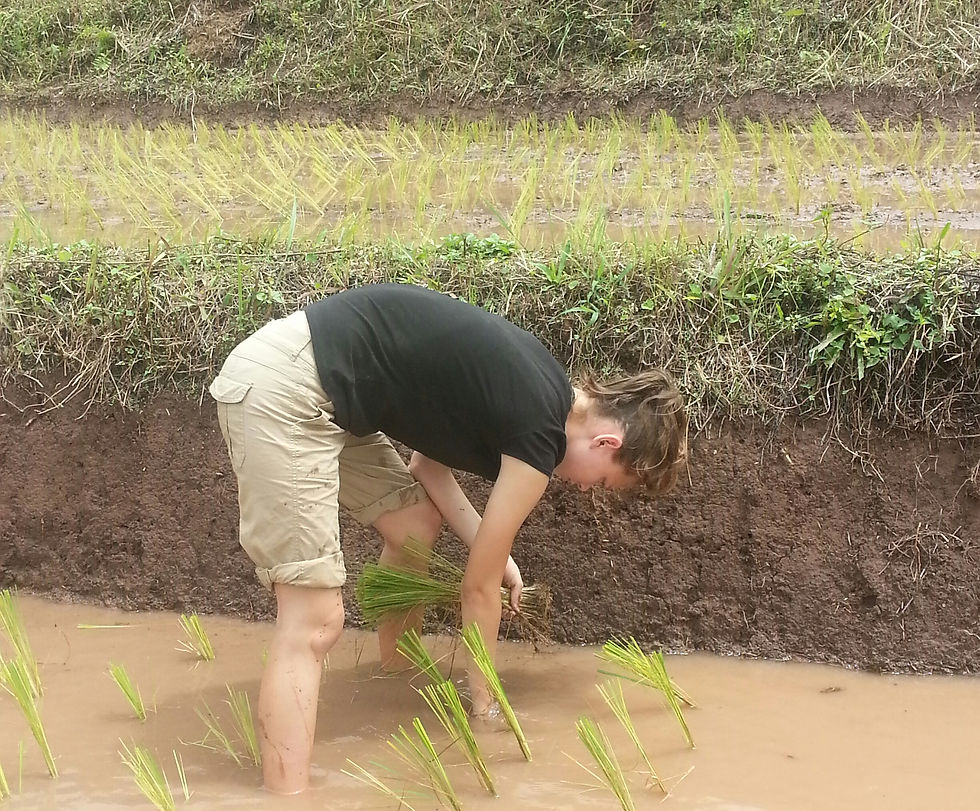Planting Rice in Thailand
- Rand Blimes

- Apr 30
- 4 min read

Note: This post is part of a series from a tiny village in northern Thailand called Mae La Oop, where I spent six weeks leading a semester-abroad program. There were no restaurants, no hotels, no tourist shops — just kind people, floor mats, and more amazing home-cooked meals than I thought one human could consume. My family and students lived with local host families, volunteered in the school, and worked alongside NGOs on grassroots development projects. It was challenging, immersive, and utterly unforgettable.
Rice is Life
I love rice. We eat it regularly at home, and I find few things as comforting as the smell of rice cooking. In many parts of Asia, rice is more than food—it’s life. Here in Thailand, when our host family calls us to a meal, they simply say, “Time to eat rice.”
In Japan, the word for breakfast literally means “morning rice.” Lunch? “Afternoon rice.” You can guess what dinner is.
Rice is life.
(Planting) Rice is Death
But rice is also death. Or at least that’s how my back feels about it now.
Yesterday, our host asked if we’d be interested in working at his farm. I know some travelers visit Karen villages and spend a day planting rice, but this felt different. Mae La Oop doesn’t do tourism. As far as I know, we were the first group of outsiders ever to stay here.
So the invitation wasn’t part of a show—it was a real gesture. And that made it feel special. But also serious.
Our host made the stakes clear:
“Your family will test in one square of field. If you can’t do it, you sit and watch me plant rice. If you can do it . . . GOOD! Plant more rice!”

Mud, Mist, and the Reality of Rice
After breakfast, we walked about a kilometer from the house to the farm. The air was misty and cool. We passed wooden houses, wandering pigs and chickens, papaya and mango trees, and fields already bright with green. The forest crept close to the road, and we danced around mud puddles with limited success.
The rice farm was carved into the hillside in wide, terraced sections. Each was surrounded by a narrow earth ridge to retain water. The terraces stepped down the hill like shallow pools—flooded and ready for planting.
Our host handed each of us a bundle of young rice plants—grass-like shoots about 10 inches long with muddy roots. We stepped down into the flooded field, our feet immediately sinking into the soft, cold muck.
No one in my family is squeamish, so the mud was a delight. The occasional dead worm or frog gave us pause, but we’ve mastered the art of selective focus.
The planting process was simple and soothing at first:
Pull. Plant. Pull. Plant. Pull. Plant. Step forward. Repeat.
We didn’t have to make neat rows. We just planted clumps of five to twenty stalks every foot or so.
For the first fifteen minutes, it was lovely. The rain was gentle. The setting was storybook. The work was rhythmic, almost meditative.
And then our backs started to scream.
None of us are used to working hunched over for hours. Soon, my spine was barking, my legs were shaking, and when I finally stood to stretch, the entire world spun.
I didn’t fall—but I thought about it.
And then I bent back over and kept planting.
Each time I stood, I braced for the dizziness. And each time, I waited it out and carried on.
After we had planted on section of the rice field, our host came to inspect our work.
We kind of hoped we would be told to sit quietly and watch the real farmers plant the rest of the field.
But no. We passed the test. We were allowed to plant more.
Why oh why did we have to be so barely competent?!
We worked three full sections before we ran out of seedlings. By mid-afternoon, we sloshed our way back to the house. We “showered” the muck off and collapsed into heaps of sore muscle and regret.
Okay, not quite. But we were sore. Very sore.
We now have a deeper appreciation for rice. And we will never again waste a single grain.
Because travel.

Other posts in the Mae La Oop Series:



Comments